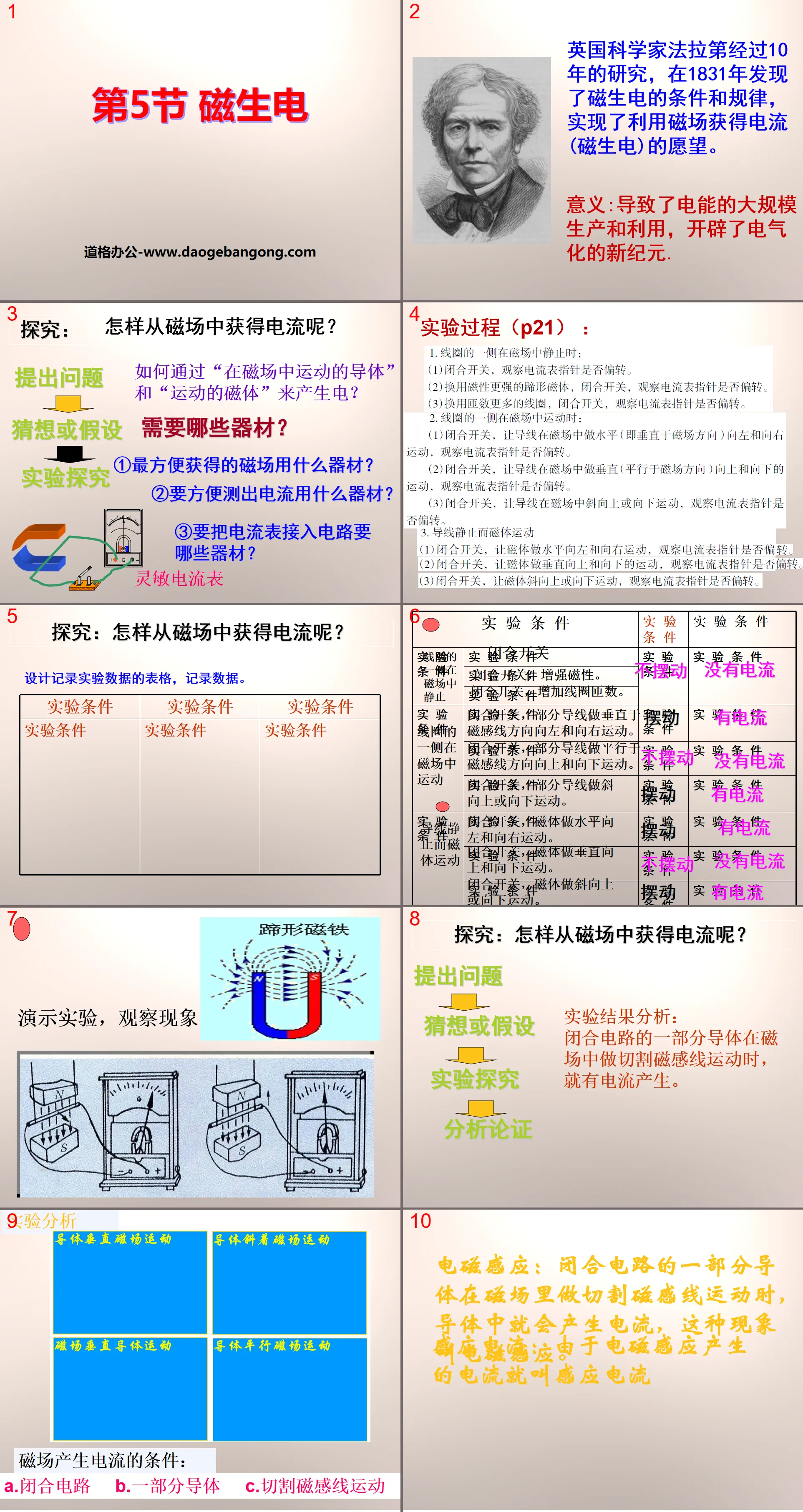Fifth Grade Science Volume 1, Textbook Edition
Science Edition for Sixth Grade Science Volume 2
Science Edition for Sixth Grade Science Volume 1
Third Grade Science Volume 2, Textbook Edition
Fourth Grade Science Volume 2, Textbook Edition
Fourth Grade Science Volume 1, Textbook Edition
Third Grade Science Volume 1, Textbook Edition
Fourth-grade science volume 2 of the E-education edition
Qingdao Edition Fourth Grade Science Volume 2
Hunan Education Edition Fourth Grade Science Volume 1
E-education edition fifth grade science volume 1
E-education edition fifth grade science volume 2
Fifth Grade Science Volume 2, Textbook Edition
E-education edition sixth grade science volume 1
Zhejiang Education Edition Seventh Grade Science Volume 2
People's Education Press Fourth Grade Science Volume 2

| Category | Format | Size |
|---|---|---|
| Zhejiang Education Edition Eighth Grade Science Volume 2 | pptx | 6 MB |
Description
"Magnetism Generates Electricity" PPT
Part One: Introduction of New Courses
After 10 years of research, the British scientist Faraday discovered the conditions and laws of magnetic electricity generation in 1831, and realized his desire to use magnetic fields to obtain electric current (magnetic electricity generation).
Significance: It has led to the large-scale production and utilization of electric energy and opened up a new era of electrification.
Explore: How to obtain current from a magnetic field?
Ask a question
How is electricity produced by a "conductor moving in a magnetic field" and a "moving magnet"?
Guess or hypothesis What equipment is needed?
Experimental exploration
①What equipment is the most convenient to obtain a magnetic field?
②What equipment should be used to easily measure the current?
③What equipment is needed to connect the ammeter to the circuit?
Magnetism generates electricity PPT, part 2 content: Classroom problems
Question: When I was doing the experiment just now, the pointer of the sensitive ammeter deflected left and right. What does it mean?
Take a guess
What factors do you think might be related to the direction of the induced current in the circuit?
It may be related to the direction in which the conductor cuts the magnetic field lines (the direction of conductor movement)
It may be related to the direction of the magnetic field
Magnetism generates electricity PPT, Part 3: Classroom examples
1: Which of the following four figures will not produce induced current ( )
(The small circle in the picture represents a part of the closed conductor)
2. When a conductor cuts magnetic field lines in a magnetic field, ___________ will occur at both ends of the conductor.
3. The direction of the induced current is related to __________ and ___________.
4. In the phenomenon of electromagnetic induction, when the conductor cuts the magnetic field lines and moves, ____________ is produced.
It can be seen that in the phenomenon of electromagnetic induction, ______ energy is converted into ______ energy.
5. Please judge:
(1) When a conductor moves in a magnetic field, it will definitely produce an induced current ( )
(2) When a conductor cuts magnetic field lines in a magnetic field, it will definitely produce an induced voltage ( )
(3) When a closed conductor cuts magnetic field lines in a magnetic field, it will definitely generate an induced current ( )
(4) When a part of a closed conductor cuts the magnetic field lines in a magnetic field, it will definitely produce an induced current ( )
Magnetism generates electricity PPT, part 4 content: exercises:
1. The conditions for generating induced current are: circuit ______, and part of the wire is ____________.
2. When a conductor cuts magnetic induction lines in a magnetic field, there must be ____________. There may not necessarily be ______ produced. If the circuit is closed, there must also be ______.
3. As shown in the figure, the magnetic field, the conductor cutting direction and the direction of the induced current have been marked in Figure A. Please mark the current directions in the four figures B, C, D and E.
Magnetism generates electricity PPT, Part 5: Three major relationships between electricity and magnetism (three major principles)
1. Electric current can produce magnetic field (electromagnetism)
2. The magnetic field exerts a force on the current
3. Use a magnetic field to obtain electric current (electromagnetic induction)
(Magnetic electricity)
Keywords: Zhejiang Education Edition eighth grade science PPT courseware for the second volume free download, magnetic electricity PPT download, .PPT format;
For more information about the PPT courseware "Magnetism Generates Electricity", please click the Magnetism Generates Electricity ppt tab.
"Magnetism Generates Electricity" Electromagnetic Phenomenon PPT Courseware 2:
"Magnetism Generates Electricity" Electromagnetic Phenomenon PPT Courseware 2 Knowledge Review 1. What is the name of this experiment? 2. Who was the first to complete this experiment? Which country? In what year was it completed? 3. What did this experiment confirm? After Oersted discovered the magnetic effect of electric current, many...
"Magnetism Generates Electricity" Electromagnetic Phenomenon PPT Courseware:
"Magnetism Generates Electricity" Electromagnetic Phenomenon PPT Courseware 1. Exploration of Magnetism Generating Electricity After Oersted discovered that electricity generates magnetism, scientists further discovered the effect of magnetism on electricity and invented an electric motor that can convert electrical energy into mechanical energy. People were asked to reflect: Can electricity and magnetism...
"Magnetism Generates Electricity" Electricity and Magnetism PPT Courseware 3:
"Magnetism Generates Electricity" Electricity and Magnetism PPT Courseware 3 Review Review Redo Oersted's experiment and think about: (1) What did Oersted's experiment illustrate? (2) Electricity generates magnetism, so can magnetism generate electricity? Have you ever seen such an instance? Under what circumstances does magnetic energy generate electricity? This experiment should choose...
File Info
Update Time: 2024-11-22
This template belongs to science courseware Zhejiang Education Edition Eighth Grade Science Volume 2 industry PPT template
"Magnetism Generates Electricity" PPT Simple campus recruitment activity planning plan summary enterprise and institution recruitment publicity lecture PPT template is a general PPT template for business post competition provided by the manuscript PPT, simple campus recruitment activity planning plan summary enterprise and institution recruitment promotion Lecture PPT template, you can edit and modify the text and pictures in the source file by downloading the source file. If you want more exquisite business PPT templates, you can come to grid resource. Doug resource PPT, massive PPT template slide material download, we only make high-quality PPT templates!
Tips: If you open the template and feel that it is not suitable for all your needs, you can search for related content "Magnetism Generates Electricity" PPT is enough.
How to use the Windows system template
Directly decompress the file and use it with office or wps
How to use the Mac system template
Directly decompress the file and use it Office or wps can be used
Related reading
For more detailed PPT-related tutorials and font tutorials, you can view: Click to see
How to create a high-quality technological sense PPT? 4 ways to share the bottom of the box
Notice
Do not download in WeChat, Zhihu, QQ, built-in browsers, please use mobile browsers to download! If you are a mobile phone user, please download it on your computer!
1. The manuscript PPT is only for study and reference, please delete it 24 hours after downloading.
2. If the resource involves your legitimate rights and interests, delete it immediately.
3. Contact information: service@daogebangong.com
"Magnetism Generates Electricity" PPT, due to usage restrictions, it is only for personal study and reference use. For commercial use, please go to the relevant official website for authorization.
(Personal non-commercial use refers to the use of this font to complete the display of personal works, including but not limited to the design of personal papers, resumes, etc.)
Preview










